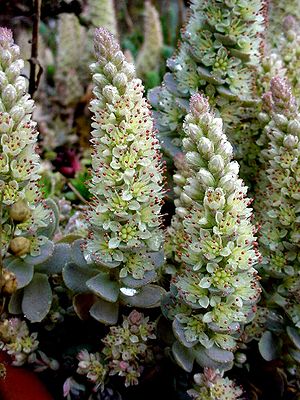Orostachys
| Orostachys | ||||||||||||
|---|---|---|---|---|---|---|---|---|---|---|---|---|

Orostachys malacophylla var. Iwarenge (Makino) H.Ohba |
||||||||||||
| Systematics | ||||||||||||
|
||||||||||||
| Scientific name | ||||||||||||
| Orostachys | ||||||||||||
| Fish. |
Orostachys is a genus of plants in the family of thick leaf plants (Crassulaceae). It also bears the German name Sternwurz . The botanical name of the genus Orostachys is derived from a Greek word óros for mountain and stáchys for ear of corn. It contains about 13 species.
description
Orostachys species are mostly biennial herbaceous plants that are more or less succulent . The roots are fibrous. In the first year the leaves stand together in solitary, basal, dense rosettes. In the second year, a 5 to 60 cm long, leafy stem is formed. The thick-fleshed leaves in particular store water. The alternate leaves are oblong to ovate and often have purple spots. The leaf ends have a cartilaginous to prickly, white tip. The leaf margins are usually smooth. Stipules are missing.
The terminal, mostly branched, total inflorescences composed of partial inflorescences are relatively large and narrow pyramidal to cylindrical in shape and contain many flowers and foliage-like bracts. The at least very short stalked flowers are hermaphroditic and five-fold. The free sepals are usually shorter than the petals. The five predominantly yellow, more rarely white, yellow-green or pink to reddish petals are almost free. There are two circles with five stamens . The yellowish nectar scales are relatively small. The upright carpels are free and contain many ovules. The stylus are narrow.
The many-seeded follicles have a beak-shaped end. The seeds are small.
Systematics and distribution
The genus Orostachys is only found in eastern Asia: China (eight species), Japan (six species), Kazakhstan , Korea (five species), Mongolia and Russia .
The first publication of the generic name Orostachys took place in 1809 by Friedrich Ernst Ludwig von Fischer in Mémoires de la Société Impériale des Naturalistes de Moscou , Volume 2, p. 270. The more frequently cited other authors Augustin-Pyrame de Candolle , Robert Sweet or Alwin Berger are not for a first publication of this genre recognized.
The genus Orostachys belongs to the subtribe Telephiinae from the tribe Sedeae in the subfamily Sedoideae within the family of Crassulaceae .
The genus is divided into two sections and includes the following species:
- Section of Orostachys
- Orostachys boehmeri (Makino) H. Hara , Origin: Japan
- Orostachys cartilaginea V.N. Borissova : It thrives on rocks of low mountains in Russia and the Chinese provinces of Heilongjiang , Jilin , Liaoning , Nei Mongol , Shandong .
- Orostachys chanetii (H.Léveillé) A. Berger : It thrives on cliffs on slopes and on house roofs at altitudes between 400 and 1700 meters in Gansu , Hebei , Shanxi , Sichuan .
- Orostachys fimbriata (Turcz.) A. Mountain : rocky areas on slopes, on house roofs and mossy tree trunks mostly below 1600 meters (up to 3500 meters in Gansu and Qinghai) in Korea, Mongolia , Russia and the Chinese provinces of Anhui , Gansu, Hebei , Heilongjiang, Henan , Hubei, Jiangsu , Liaoning, Nei Mongol, Ningxia , Qinghai , Shaanxi , Shandong , Shanxi, Zhejiang .
- Orostachys japonica (Maxim.) A. Berger : It thrives on rocks of low mountains, along rivers in Japan, Korea, Russia and the Chinese provinces of Anhui, eastern Heilongjiang, Jiangsu, Shandong, Zhejiang.
-
Orostachys malacophylla (Pall.) Fish. : It thrives in crevices at altitudes between 1200 and 1800 meters in Japan, Korea, Mongolia, Russia and the Chinese provinces of Hebei, Heilongjiang, Jilin, Liaoning, Nei Mongol; with the subspecies and varieties:
- Orostachys malacophylla subsp. lioutchenngoi H. Ohba
- Orostachys malacophylla subsp. malacophylla
- Orostachys malacophylla var. Aggregata (Makino) H. Ohba
- Orostachys malacophylla var. Iwarenge (Makino) H. Ohba
- Orostachys paradoxa (Khokhr. & Vorosch.) Czerep.
- Orostachys spinosa (L.) Sweet , native to: Siberia, Amur region, China, Mongolia, Tibet, Central Asia, South Urals
- Orostachys thyrsiflora fish. : It thrives on slopes in steppes and on sunny slopes in mountains at altitudes between 1000 and 2100 meters in Kazakhstan , Mongolia, Russia and the Chinese provinces of Gansu, Xinjiang, Xizang.
- Section Schoenlandia H. Ohba
-
Orostachys aliciae (Raym.-Hamet) H. Ohba , with the varieties:
- Orostachys aliciae var. Aliciae
- Orostachys aliciae var. Komarovii (Raym.-Hamet) H. Ohba
- Orostachys schoenlandii (Raym.-Hamet) H. Ohba
- Orostachys stenostachya (Fröd.) H. Ohba .
-
Orostachys aliciae (Raym.-Hamet) H. Ohba , with the varieties:
use
Some species are used as ornamental plants .
The medicinal effects of Orostachys japonica have been studied.
swell
- Kunjun Fu, Hideaki Ohba & Michael G. Gilbert: Crassulaceae in der Flora of China , Volume 8, p. 206: Orostachys - Online. (Section description and systematics)
- Ghulam Rasool Sarwar: Crassulaceae in the Flora of Pakistan : Orostachys - Online. (Section description)
- S. Mayuzumi & H. Ohba: The phylogenetic position of East Asian Sedoideae (Crassulaceae) inferred from chloroplast and nuclear DNA sequences. , in Systematic Botany , 29, 2004, pp. 587-598. (Section systematics)
- Walter Erhardt among others: The big pikeperch. Encyclopedia of Plant Names . Volume 2. Verlag Eugen Ulmer, Stuttgart 2008. ISBN 978-3-8001-5406-7
Individual evidence
- ↑ VV Byalt, & IV Sokolova: Who is the author of the name Orostachys (Crassulaceae)? , in Taxon , 48, pp. 63-65. 1999.
- ↑ Hideaki Ohba: Orostachys . In: Urs Eggli: Succulents Lexicon Volume 4. Crassulaceae (thick-leaf plants) . 2003, pp. 193-197
- ↑ Entry in Plants for a Future. (engl.)

